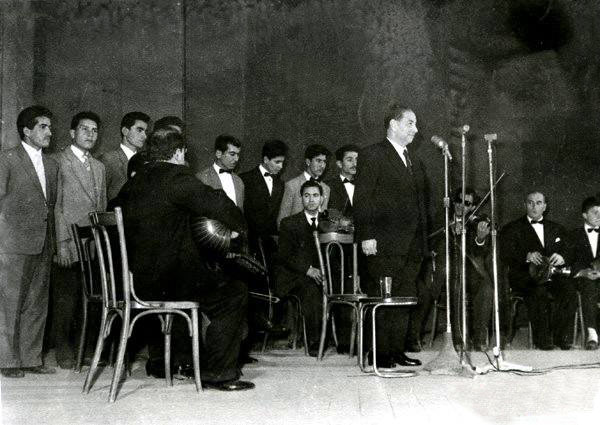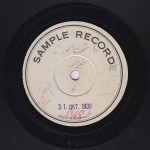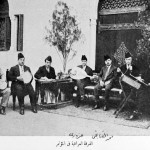The Arab Music Archiving and Research foundation (AMAR), in collaboration with the Sharjah Art Foundation (SAF), presents “Min al-Tārīkh”.
Dear listeners,
Welcome to a new episode of “Min al-Tārīkh”.
Today we will resume our discussion about al-ṭarīqa al-Qubbāngiyya, its founder Muḥammad al-Qubbāngī, and the last phase in his life, with our guest Mr. Husayn al-A‘zami.
In the 1940s and 1950s, al-Qubbāngī started expanding his band and singing maqām-s accompanied by an orchestra/a large band.
Of course…
Why?
He understood and felt the importance of the musical band’s vocal outcome: he was aware that the band’s vocal outcome was proportional to its size, and also that himself would achieve more salṭana if this vocal outcome was significant enough to his musical ear. I too would rather sing with a large band than with a small one, as a principle.
But what is a large band but a collection of violins? What did he add?
It doesn’t matter… Violins create an incredibly beautiful outcome.
But they played in unison and thus cancelled all improvisation… No one could play a taqsīm, unless there was a solo instrumentalist who was given the measure by the others. At that point, what is the difference between having twelve violins or just one?
(♩)
Here is a beautiful occurrence: I was invited in 2002 by the Center of Arab and Mediterranean Music in Sidi Bou Said in Tunisia to celebrate the 70th anniversary of the Cairo Congress of Arab Music as well as to commemorate the death of one of its major founders, Baron d’Erlanger.
He died right after the Congress, so it was at once the 70th anniversary of his death and the 70th anniversary of the Congress of Arab Music. The Tunisians invited all the countries that had participated in the 1932 Congress and asked their new generation of singers or artists to sing what their ancestors had sung at the 1932 Congress in Cairo. They sent me to Baghdad a CD of Muḥammad al-Qubbāngī and asked me to sing these maqām-s in Tunisia. So I went there and sang Muḥammad al-Qubbāngī’s maqām-s at the celebration of the 70th anniversary of the Congress of Arab Music.
The second occurrence took place five years later on the occasion of the Diamond commemoration –i.e. the 75th anniversary– of the 1932 Cairo Congress of Arab Music: I was also invited by the Arab Music Congress when the academic forum organised this celebration. I went there as a singer as well as a researcher since I sang at the Cairo Opera House and also presented a research on this occasion at this forum. While singing on stage on March 13th 2007, I had the strange feeling that al-Qubbāngī had stood on the same exact stage 75 years earlier, on the same exact day, i.e. on March 13th, and had sung Iraqi maqām-s… and that here I was, 75 years later, his grandson, also singing Iraqi maqām-s at the commemoration of this Congress, and at the commemoration of this Qubbāngī celebration in Cairo.
Sir, you are his grandson in melody. And God willing you will live to see your own grandchildren in melody too!
God protect you!
Let us end our episode with a maqām I like: the beautiful maqām khanabāt that he recorded on two sides of a 30cm disc with Shakhmaqgī in the 1940s, accompanied by Jamīl Bashīr (violin) and three lady madhhabgī-s singing in beautiful harmony. In fact, everything in this maqām is truly beautiful.
With the khanabāt we reach the end of today’s episode.
We will meet again in a new episode to resume our discussion about al-ṭarīqa al-Qubbāngiyya and the disciples of Muḥammad al-Qubbāngī.
Here is Mr. Muḥammad al-Qubbāngī accompanied by his musical band …
“Min al-Tārīkh” is brought to you by Mustafa Said.
- 221 – Zakariyya Ahmed – 12 (1/9/2022)
- 220 – Zakariyya Ahmed – 11 (1/9/2022)
- 219 – Zakariyya Ahmed – 10 (11/25/2021)
- 218 – Zakariyya Ahmed – 9 (10/26/2021)
- 217 – Zakariyya Ahmed – 8 (9/24/2021)
- 216 – Zakariyya Ahmed – 7 (9/4/2021)
- 215 – Zakariyya Ahmed – 6 (8/28/2021)
- 214 – Zakariyya Ahmed – 5 (8/6/2021)
- 213 – Zakariyya Ahmed – 4 (6/26/2021)
- 212 – Zakariyya Ahmed – 3 (5/27/2021)
- 211 – Zakariyya Ahmed – 2 (5/1/2021)
- 210 – Zakariyya Ahmed – 1 (4/28/2021)
- 209 – W-al-Lāhi lā astaṭī‘u ṣaddak 2 (4/6/2017)
- 208 – W-al-Lāhi lā astaṭī‘u ṣaddak 1 (3/30/2017)
- 207 – Bashraf qarah baṭāq 7 (3/23/2017)



